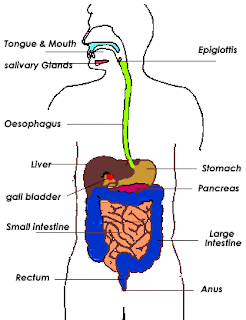
Basically we need to digest large molecules because they are too large to pass across any cell membrane. As the image shows we make the molecules " our own" in order to be digested.
source: http://click4biology.info/c4b/6/hum6.1.htm#one
6.1.2 Explain the need for enzymes in digestion
-Enzymes are protein molecules which act as catysts for reactions.
-As we can see in the graph , the need of enzymes in digestion is essential. It reduces the activation energy that a normal reaction would need, obtainig the same product.
-The need of energy in order to digest without enzymes is ilustrated in the graph. There is a big gap between the reaction without enzymes and the reaction with enzymes.
6.1.3 State the source , substrate, products an optimum PH conditions for one amylase, one protease and one lipase:
source : salivary glands
substrate : amylose (starch)
product: maltose and glucose (sugar)
pH : neutral (pH 7)
Source : pancreas cells
Substrate: Lipids
Porducts : Glycerol and fatty acids
pH : neutral (pH 7)
Source: stomach cells
Substrate : proteins
Products: aminoacids
pH: 3 (acid)
http://www.bbc.co.uk/schools/ks3bitesize/science/organisms_behaviour_health/diet_drugs/revise5.shtml
6.1.4 Draw and label a diagram of the digestive system
6.1.5 Outline the function of the stomach , small intestine and large intestine
a)Stomach: When you swallow your food is forced down yo your stomach through the esophagus. The stomach helds your food for a period of time. Also in the stomach is where the digestion of protein begins.
- the acid that is in your stomach activates the pesin and kill bacterias that could cause food poisoning.
b)Small Intestine : In the small intestine is where the food is finally digested. The inner wall of the intestine is formed by small structures called Villi (shown in the image ) which is covered by another structure called.
Villies make absorption possible, they absorb food molecules so they can be assimilated and become part of the tissues of the body.
The microvilli increases the surface for the absorption process.
Large intestine: Basically the primary function of the large itnestine is to absorve water. But the large intestine also works as refuge for bascterias including escherichia coli. We provide nutrients water and an enviroment for them while they synthesize vitamin K for us.
6.1.6 Distinguish between absorption and assimilation
a) absorption is when the nutrients are absorbed into the circulatory system
b) When the nutrients travel to different tissues in the ciruclatory system , the nutrients are absorbed by the tissue cells , and become part of the body cells. This is called assimilation
6.1.7 Explain how the structure if the villus is related to its role in absorption and transport of the products of digestion

The structure of the villi is specific. The villus are structures present in the smaill intestine that increase the surface area in order to absorb the molecules.
The villi surface is covered with microvilli, which increases the surface area .
Also the villi has a one cell layer so food can be absorbed easily . The clood capilarries are really close to the one cell layer making it easy for the molecules to pass to the circulatory system.







.JPG)
No hay comentarios:
Publicar un comentario